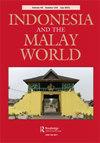从Sialang树上采集蜂蜜
IF 0.9
3区 社会学
0 ASIAN STUDIES
引用次数: 1
摘要
本文讨论了来自苏门答腊岛南部明古鲁省西拉威地区的两份手稿,这两份手稿用中马来语用乌鲁文字写成,讲述了从锡兰树上采集蜂蜜的情况。nyialang仪式是从森林中sialang树(Caesalpiniaceae)上的蜂箱中提取蜂蜜的过程,由伊玛目sialang或pawang sialang领导,并由四到五个学徒或anak sialang协助。nyialang仪式是在特定的时间以特定的方式进行的,基于蜂蜜起源的神话。这两份手稿保存在Bengkulu国家博物馆,编号为MNB 07.91(包含文本A)和MNB 07.135(包含文本B)。A名为Caro ngambiak madu siyalang, B名为Caro nyialang,都是“如何收获sialang蜂蜜”的意思。每个文本都由“陈述”元素组成,描述了nyialang仪式中的行为或蜂蜜起源神话的相关部分,以及dunday元素,即在进行相关行动时发出的咒语。这两个文本显然都是作为作者和读者如何进行nyialang仪式的指南或辅助备忘录而写的。每一个都是由一个知识渊博的人写的,他掌握了仪式的所有细节,即伊玛目sialang,目的是解释nyialang仪式与口头传说中蜂蜜起源的神话之间的关系。本文章由计算机程序翻译,如有差异,请以英文原文为准。
Collecting Honey from Sialang trees
ABSTRACT This article discusses two manuscripts from the Serawai region of Bengkulu province in southern Sumatra, written in Middle Malay in ulu script, concerning the collecting of honey from sialang trees. The nyialang ritual is the process of taking honey from bee hives built in sialang trees (Caesalpiniaceae) in the forest, led by an imam sialang or pawang sialang and assisted by four or five apprentices or anak sialang. The nyialang ritual is performed at certain times and in a specific way, based on the myth of the origin of honey. The two manuscripts, held at the State Museum of Bengkulu, are MNB 07.91 (containing text A) and MNB 07.135 (containing text B). A is entitled Caro ngambiak madu siyalang and B is entitled Caro nyialang, both meaning ‘How to harvest sialang honey’. Each text consists of ‘statement’ elements, describing actions in the nyialang ritual or the revelant part of the myth of the origin of honey, and dunday elements, namely mantras that are uttered when the relevant action is carried out. Both texts were evidently written as a guide or aide-memoire for both the writer and the reader on how to carry out the nyialang ritual. Each was certainly written by a knowledgable person who had mastered all the details of the ritual, namely the imam sialang, with the intention of explaining how the nyialang ritual relates to the myth of the origin of honey in oral tradition.
求助全文
通过发布文献求助,成功后即可免费获取论文全文。
去求助
来源期刊

Indonesia and the Malay World
ASIAN STUDIES-
CiteScore
2.00
自引率
0.00%
发文量
17
期刊介绍:
Indonesia and the Malay World is a peer-reviewed journal that is committed to the publication of scholarship in the arts and humanities on maritime Southeast Asia. It particularly focuses on the study of the languages, literatures, art, archaeology, history, religion, anthropology, performing arts, cinema and tourism of the region. In addition to welcoming individual articles, it also publishes special issues focusing on a particular theme or region. The journal is published three times a year, in March, July, and November.
 求助内容:
求助内容: 应助结果提醒方式:
应助结果提醒方式:


